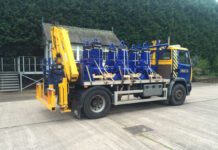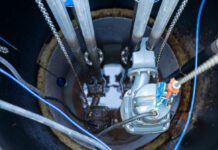Pump blockages resulting from large quantities of grit, debris and fibrous matter is a problem faced almost daily by operators of wastewater and effluent treatment plants
FOULING of pump impellers is a long-standing difficulty that costs companies a great deal of money in terms of plant downtime, pump repair and even complete replacement.
Where grit and sand are encountered, pumps can literally grind themselves to pieces so using equipment that can withstand abrasive materials and give trouble-free performance over long periods should be the main consideration during the specification process. One example can be found at United Utilities’ Sandon Dock wastewater treatment plant in Liverpool where Wemco M4C torque-flow pumps have provided low maintenance, trouble-free performance in handling grit and transferring sludge for many years.
The current works were commissioned in 1991 and is the second largest wastewater treatment plant in the north west of England. Receiving flows from the 29km Liverpool Interceptor Sewer, it is capable of treating up to 950 million litres, or 11,000l/sec, of sewage a day.

The removal of grit at the wastewater intake stage is where the Wemco pumps are first employed. In an ‘operating and standby’ configuration, the units run 24 hours a day, delivering a flowrate of 47m³/hr and head of up to 15 metres to remove the settled grit from four wastewater intake tanks. In spite of the considerable and aggressive solids content, United Utilities reports that the only maintenance the grit pumps require is the occasional replacement of the mechanical seals.
Further along in the treatment process, the grit-free wastewater is transferred into six settling tanks where it is held for up to 10 hours to allow the agitator blades to move solids to the bottom where they settle as sludge. Each tank is equipped with three Wemco M4C pumps for the purpose of removing the sludge from the tanks and transferring it to the dewatering plant. These pumps are virtually identical to the models used for grit transfer and maintenance involves only routine oil changes, plus the occasional mechanical seal replacement.
Maintenance is easy and can be undertaken in situ as the pumps are simple to strip down, due to the pump design which allows the casing to be removed from the front end and giving ready access to all internal components. In the decade the sludge pumps have been operating, no refurbishment work has been required on the impellers.
The Wemco Model C torque-flow pump can withstand the harshest of conditions because of its hydraulic vortex pump technique which is based on the principle of a whirlpool. The vortex is created by the rotating recessed cup-shaped impeller extending into the suction line, drawing the liquid / solids into the pump and then quickly through the discharge, whilst minimising the fluid / solids contact with the impeller and volute. This simple design allows solids to pass through the pump without choking the impeller, so reducing pump wear and the potential for blockages.
“The fully recessed cup-shaped impeller and free passageways within the pump casing offer almost total freedom from blockages when handling rags and fibrous solids typically encountered in waste water treatment plants,” explained AxFlow’s Wemco pump manager Mark Redgrove. “The standard option of high chrome iron for the wet end, the hydraulic design and thickened wear sections provide a more than adequate combination to deal with grit and silica sands carried into the treatment works.”
With radial impeller design pumps, grit is discharged at high velocity against the pump casing or the wear ring. Unlike radial impeller vortex pumps, the cupped impeller action of the Wemco pump deflects material away from the case and back into the flow stream towards the extra-thick sacrificial suction piece.
Behind the impeller is a high chrome iron wear plate that can withstand the grinding action of grit. And to further maximise performance and minimise wear, the large diameter impeller design is the key to pump’s considerable durability and non-clogging performance.
Because the suction end is exposed to the greatest abrasive wear, Wemco designed the pump case in two parts. The replaceable suction piece is sacrificial, even though it is designed for long wear life. Replacing it is an easy operation involving breaking the suction flange, removing the slotted bolts and then installing the new suction piece. The job can be performed in just a few hours and is said to be considerably cheaper than a completely new pump case.
“The Wemco Torque-Flow range comprises various configurations, including close-coupled, horizontal or vertical mounting, cantilever designs and a small range of submersible units,” said Redgrove. “As a result, we can satisfy many of the challenging wastewater and effluent pumping applications that face both the water utilities and companies which generate large volumes of solids-borne waste liquids.”
More recently, AxFlow has introduced the Wemco WSP, a heavy duty self-priming pump for clean or solids-laden liquids. The company believes the new unit has “great potential” in the water and wastewater treatment sector where self-priming pumps are suited to any duty with a suction lift where ease of access to the pump is necessary for maintenance purposes.
The WSP contains an open type, two-vane impeller manufactured in a choice of cast iron or CD4MCu. The wear plate is also made from cast iron and the casings are in ductile iron. It is that build quality that enables the pump to handle both clean and aggressive fluids, the solids handling being excellent for this range with the maximum for a solid sphere being 38mm on the 50mm pump and 75mm on the 250mm pump.






